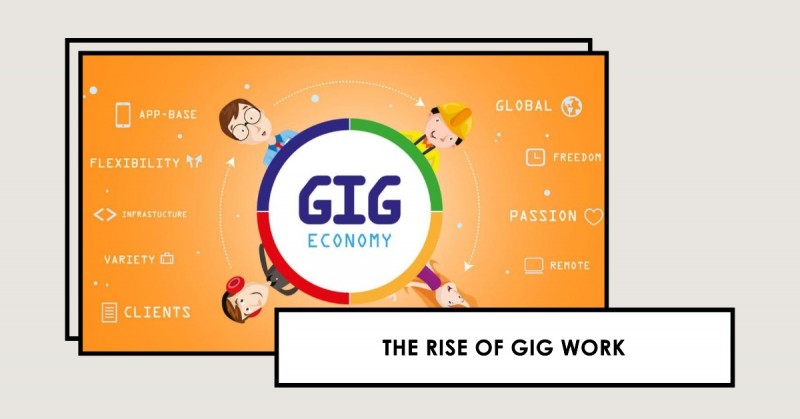
The gig economy has emerged as a significant phenomenon in the labor market, reshaping the way people work and earn a living. In this article, we will explore the rise of gig work and its influence on the labor market, shedding light on its advantages, disadvantages, impact on the workforce, policy considerations, economic implications, and future trends.
Introduction
The labor market has witnessed a transformation in recent years with the advent of the gig economy. The gig economy refers to a labor market characterized by the prevalence of short-term, flexible, and freelance work arrangements. It has gained momentum due to various factors such as technological advancements, changing work preferences, and evolving business models.
The gig economy encompasses a wide range of work arrangements where individuals offer their skills, services, or expertise on a project or task basis. It is characterized by temporary engagements, independent contracting, and the use of online platforms to connect workers with clients. Gig work can include freelancing, independent consulting, driving for ride-sharing services, delivering groceries, or participating in online platform-based tasks.
The gig economy has experienced significant growth in recent years, driven by several factors. Technological advancements and the rise of online platforms have made it easier for individuals to connect with potential clients or customers. The ability to work remotely and the desire for flexible schedules have also contributed to the expansion of the gig economy.
Gig work encompasses a diverse range of job types and industries. Some common types of gig work include freelancing and independent contracting, where individuals offer their services directly to clients. Online platform-based work is another category, where individuals complete tasks or provide services through digital platforms. Additionally, there are task-based and on-demand jobs that allow individuals to perform specific tasks or services as needed.
The gig economy offers several advantages and disadvantages for workers. On the positive side, gig work provides flexibility and autonomy, allowing individuals to choose when, where, and how much they work. It also offers diverse job opportunities and the potential for entrepreneurship. However, there are downsides to gig work as well, including the lack of benefits and protections typically associated with traditional employment, income volatility, and limited career growth opportunities.
4.1 Pros of Gig Work
Gig work provides individuals with the freedom to set their own schedules and work on projects that align with their skills and interests. It offers a wide range of job opportunities, enabling workers to explore various industries and gain diverse experiences. Moreover, gig work allows individuals to embrace their entrepreneurial spirit by starting their own businesses or consulting practices.
4.2 Cons of Gig Work
While gig work offers flexibility, it often lacks the stability and benefits that come with traditional employment. Gig workers typically do not receive benefits such as health insurance, retirement plans, or paid time off. Additionally, income can be unpredictable, leading to financial insecurity. Furthermore, gig work may not provide the same opportunities for career growth and advancement as traditional employment.
The rise of the gig economy has had a profound impact on the labor market. It has challenged the traditional employer-employee relationship and disrupted traditional industries. Many individuals now choose gig work over traditional employment due to the flexibility and autonomy it offers. This shift in workforce dynamics has implications for wages, income distribution, and job stability.
The gig economy has raised important policy and regulatory considerations. Questions have emerged regarding the classification of gig workers, their employment rights, and the need for safeguards and protections. Labor laws and regulations need to adapt to the evolving nature of work to ensure fairness and adequate protections for gig workers.
The gig economy contributes to economic growth in various ways. It fosters innovation by enabling individuals to pursue their entrepreneurial aspirations and launch new businesses. Gig work also provides economic opportunities for those who may face barriers to traditional employment. However, it can also lead to challenges for traditional industries and raise questions about income inequality and social protections.
Looking ahead, the gig economy is expected to continue evolving. Technological advancements, including automation and artificial intelligence, may further shape the gig economy. Shifting attitudes towards work and the desire for more flexible arrangements are likely to influence the labor market. Policymakers, businesses, and workers will need to adapt to these changes and find ways to address the challenges and opportunities that lie ahead.
Conclusion
The gig economy has revolutionized the labor market, offering individuals new ways to work and earn a living. While it provides flexibility and diverse opportunities, it also presents challenges such as income volatility and limited benefits. Policymakers and businesses must navigate these complexities to ensure fair treatment and protection for gig workers while harnessing the economic potential of this growing sector.
Inflation is ruling not letting the world get rid of it
UK Faces Unprecedented Inflation Crisis: Rising Prices Strain Wallets, Threaten Economy